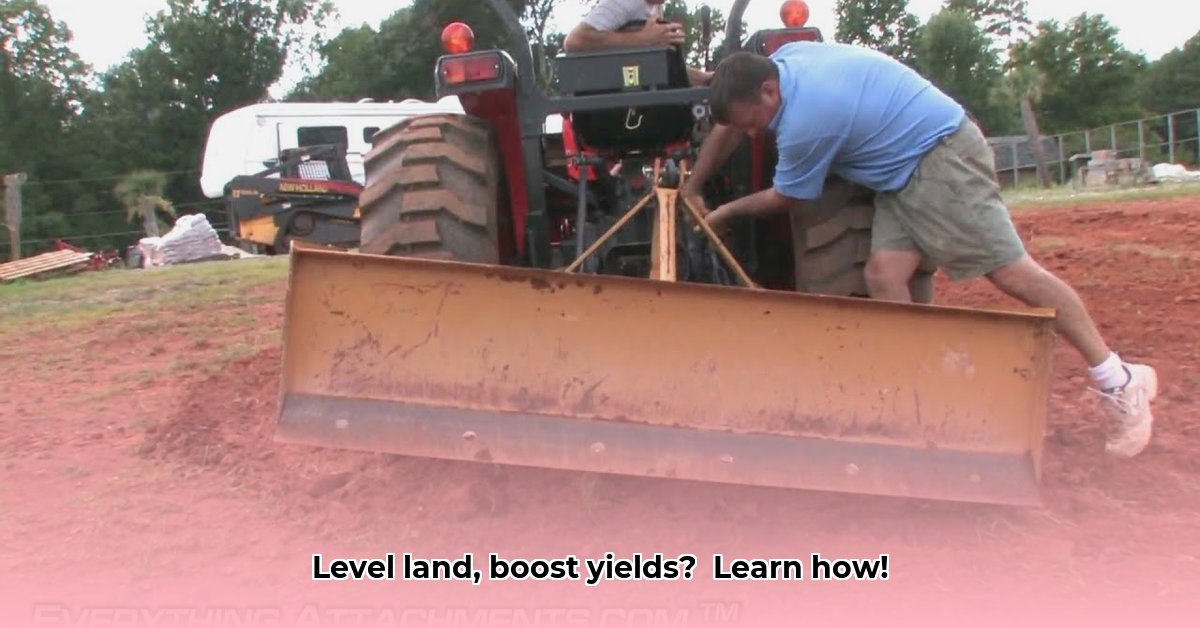
How to Use a Box Blade on a Tractor: A Step-by-Step Guide
Ready to transform your land management practices? A box blade, attached to your tractor, is a versatile tool that can level land, grade slopes, spread materials, and more. This comprehensive guide will take you from novice to confident box blade operator, regardless of your experience. We'll focus on safety, efficiency, and achieving professional results. For more on land clearing, check out this helpful resource on best tractor attachments.
Pre-Operation Checklist: Safety First!
Before you even start the tractor, a thorough pre-operation check is crucial. This prevents costly repairs and, more importantly, protects you from injury.
- Hydraulic Fluid Check: Verify the hydraulic fluid level is correct. Low fluid can severely impact performance and safety.
- Box Blade Inspection: Carefully examine the box blade for loose bolts, bent parts, or any signs of damage. Address any issues before operation.
- Work Area Clearance: Thoroughly clear the work area of rocks, debris, and any obstacles. This prevents damage to the equipment and potential hazards.
- Personal Protective Equipment (PPE): Always wear safety glasses, sturdy gloves, and close-toed boots. Consider a hard hat, especially in environments with overhead hazards.
Attaching Your Box Blade
Attaching the box blade is a straightforward process, but precision is key for optimal performance.
- Alignment: Position the tractor so the three-point hitch aligns perfectly with the box blade's hitch points.
- Hitch Pin Engagement: Securely insert and fasten the hitch pins. Double-check that they're firmly in place and locked.
- Top Link Adjustment: Adjust the top link to control the blade angle. This setting is crucial for various tasks, like leveling or grading (explained later).
Mastering the Top Link: Controlling Blade Angle
The top link is the key to controlling the box blade's angle, impacting its effectiveness for different tasks. Experimentation will help you find the optimal setting for each project.
Scarifier Settings (If Applicable): Breaking Up Compacted Soil
Many box blades feature adjustable scarifiers (small teeth). These are excellent for breaking up hard, compacted soil. Start with a shallower depth and gradually increase as needed. Remember, aggressive settings can cause uneven results.
Leveling the Land: Achieving a Smooth Surface
Leveling land requires a gentle touch and careful control.
- Low Speed Operation: Begin at a low speed to allow for precise control and adjustments.
- Multiple Passes: Multiple passes are often necessary to achieve a smooth, even surface. Observe and correct any dips or high spots.
- Depth Adjustment: Adjust the depth of the blade as needed. Start shallow and gradually increase.
Did you know? Proper leveling can significantly improve water drainage and soil aeration, boosting yields by up to 15% according to research by the USDA.
Grading Your Landscape: Creating Slopes and Drainage
Grading involves creating slopes by moving soil from higher areas to lower points. It’s similar to leveling, but with a deliberate and controlled angle. Start with the minimal amount of angle needed for optimal results. Multiple passes are typically required to achieve even grade.
Spreading Materials: Even Distribution is Key
Using the box blade to spread materials such as gravel or topsoil requires a steady hand. Maintain a consistent speed and angle to achieve even coverage. Adjust depth as needed to control the spread thickness.
Detaching the Box Blade: Safely Removing the Equipment
Detaching follows the reverse steps of attachment. Lower the box blade carefully and securely remove the hitch pins. Double-check to ensure everything is properly disconnected before driving away.
Maintenance and Troubleshooting: Extending the Box Blade's Lifespan
Regular maintenance is essential for keeping your box blade in good working condition. Inspect for worn parts, lubricate moving components, and store it properly to prevent rust.
Safety Precautions: A Constant Reminder
- Always wear appropriate PPE: Safety glasses, gloves, sturdy boots, and a hard hat are critical.
- Never operate heavy equipment if you are tired or distracted.
- Be mindful of your surroundings and potential hazards.
Do you know that neglecting safety can lead to significant injury or equipment damage? Always prioritize safety.
Conclusion: Mastering the Art of Box Blade Operation
Mastering the box blade takes practice, but the rewards are significant. With consistent practice and attention to these techniques, you'll transform your land management, improving efficiency, and boosting your yields. Remember, start slow, practice consistently, and always prioritize safety.